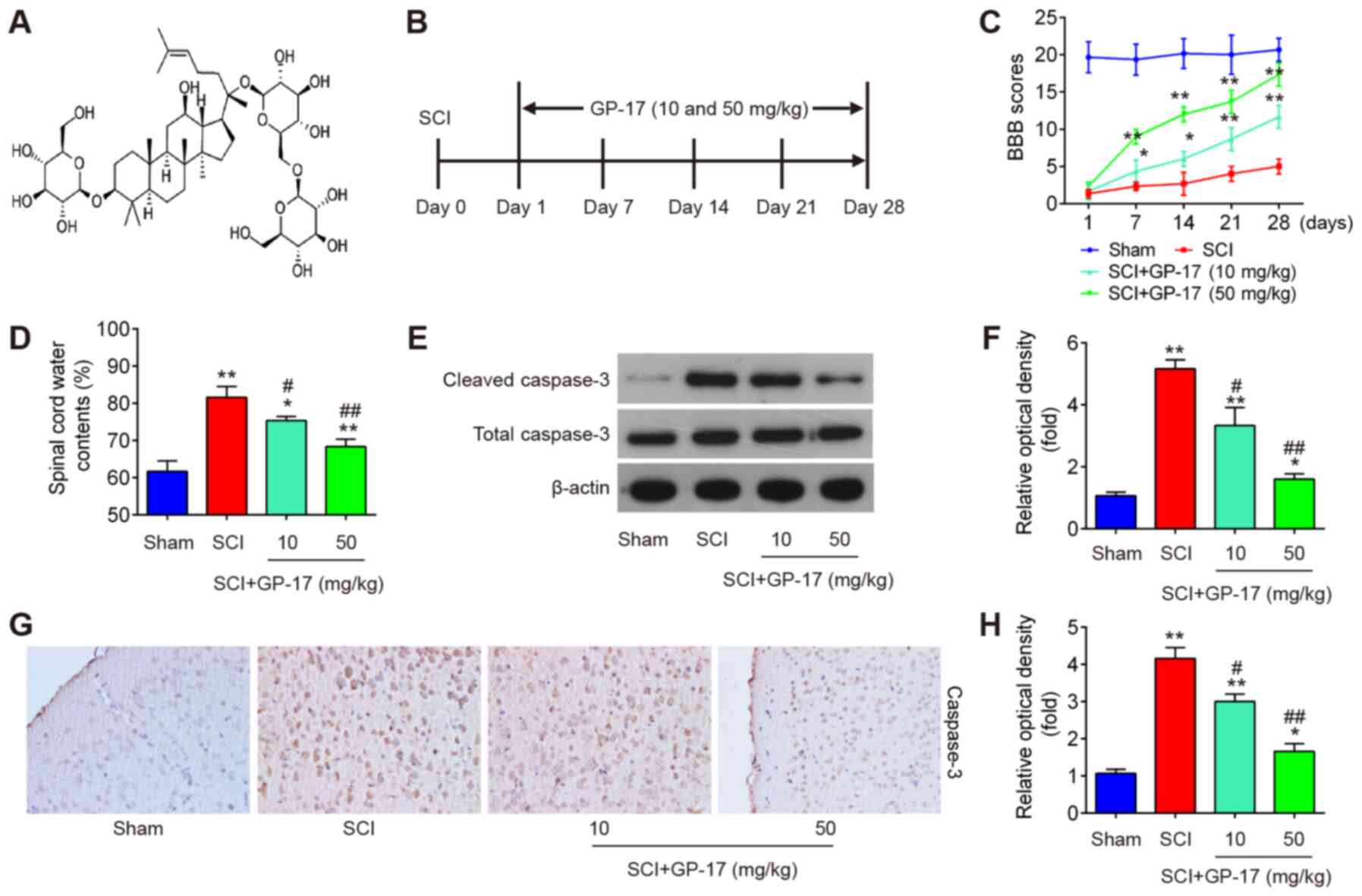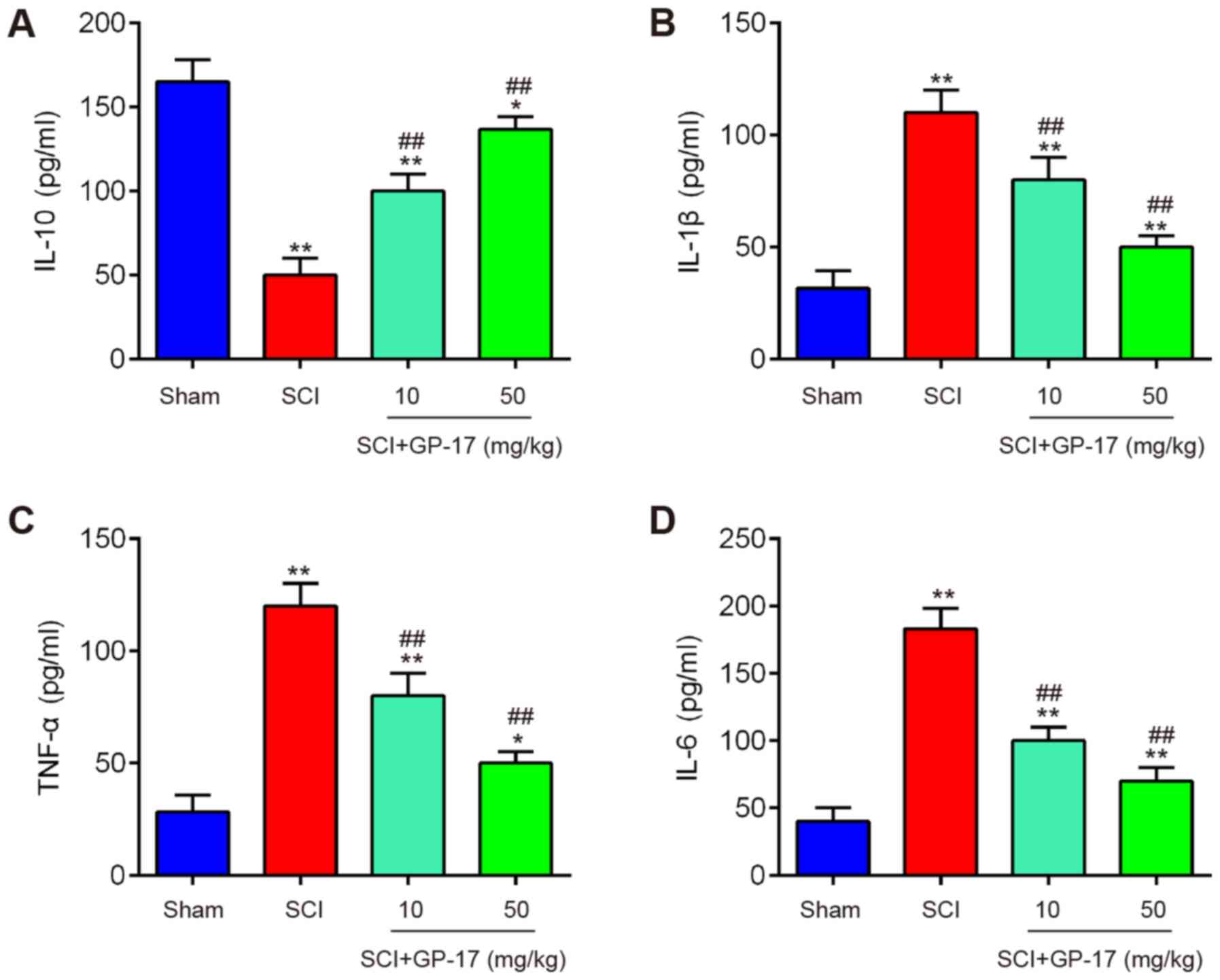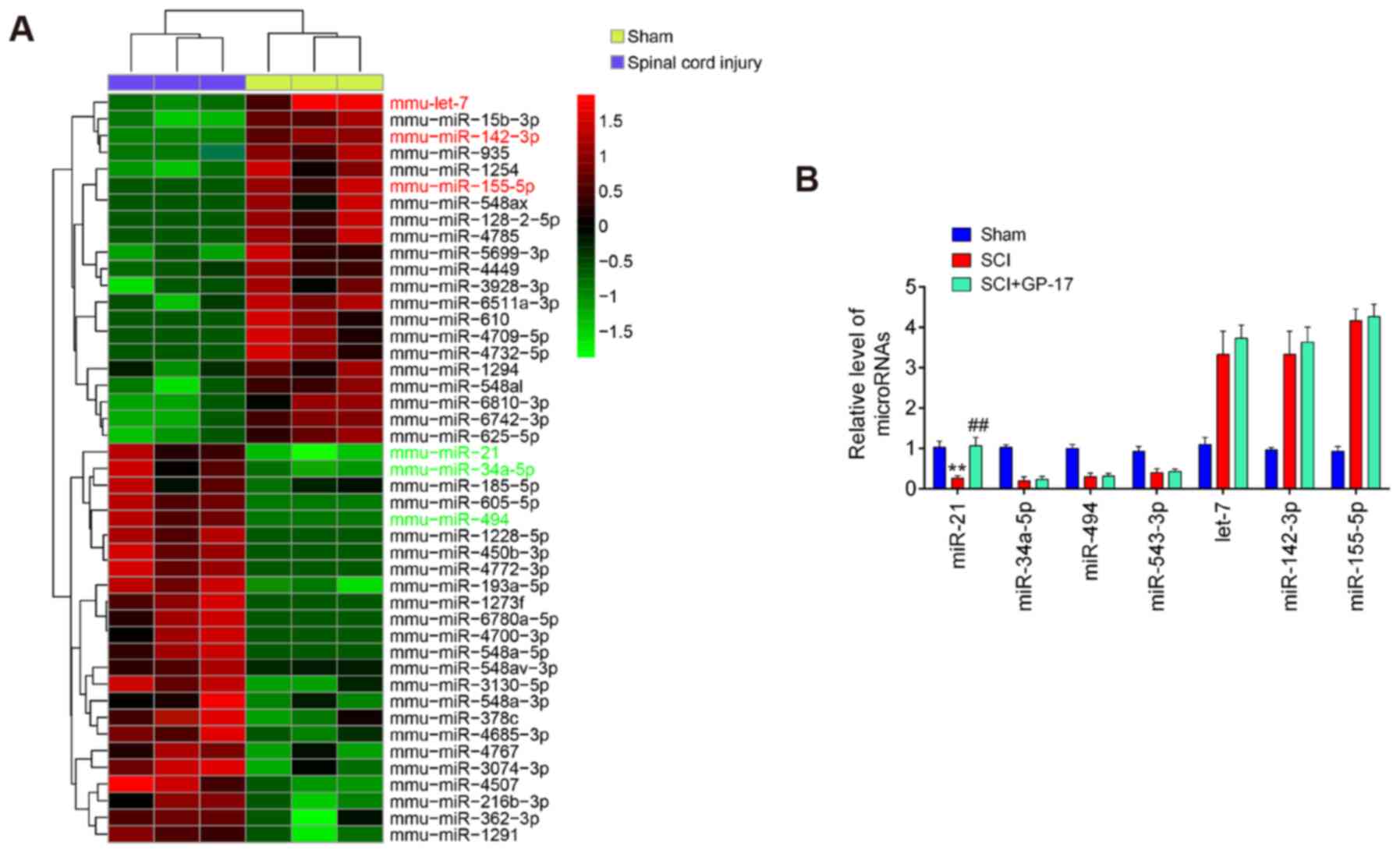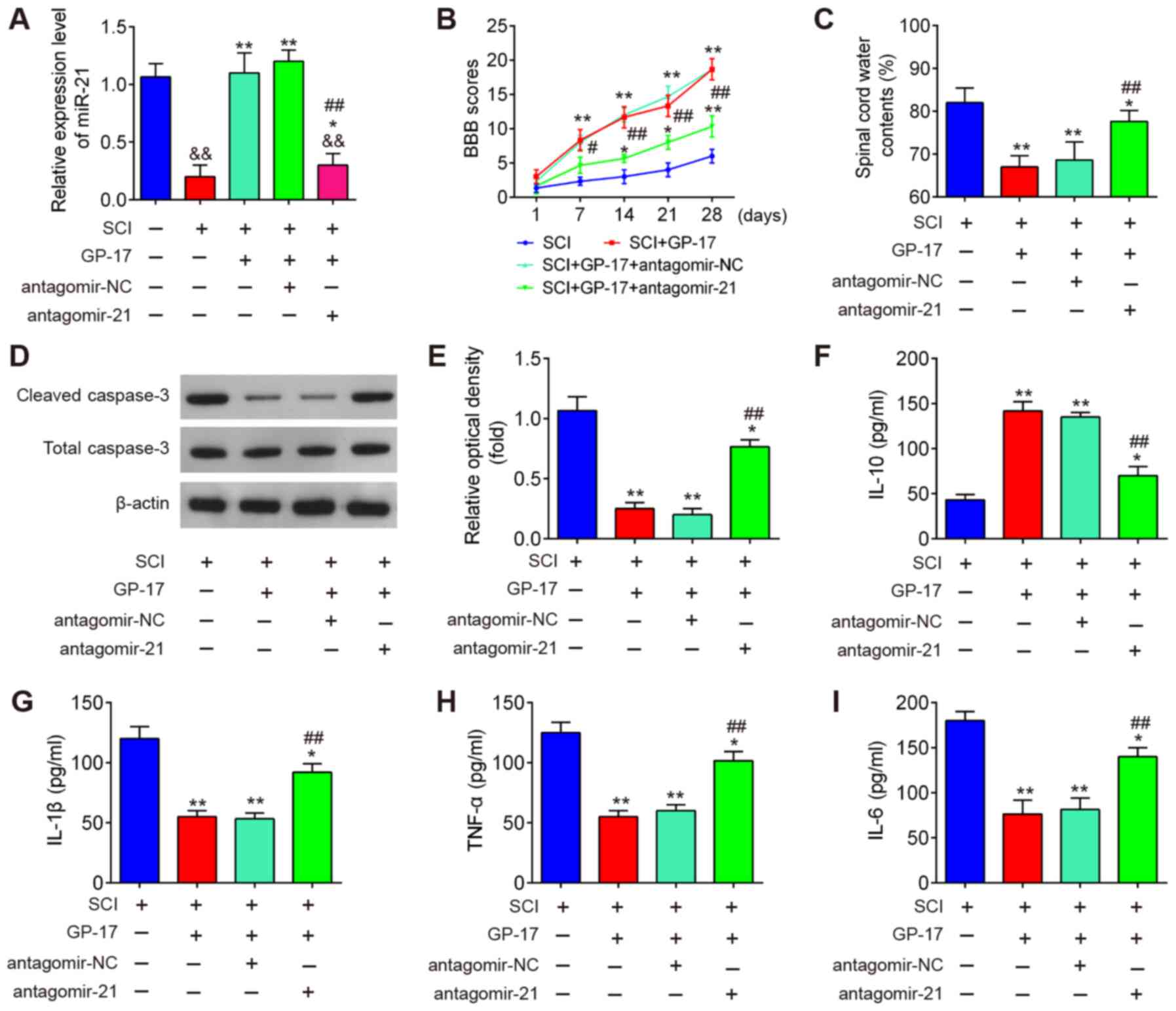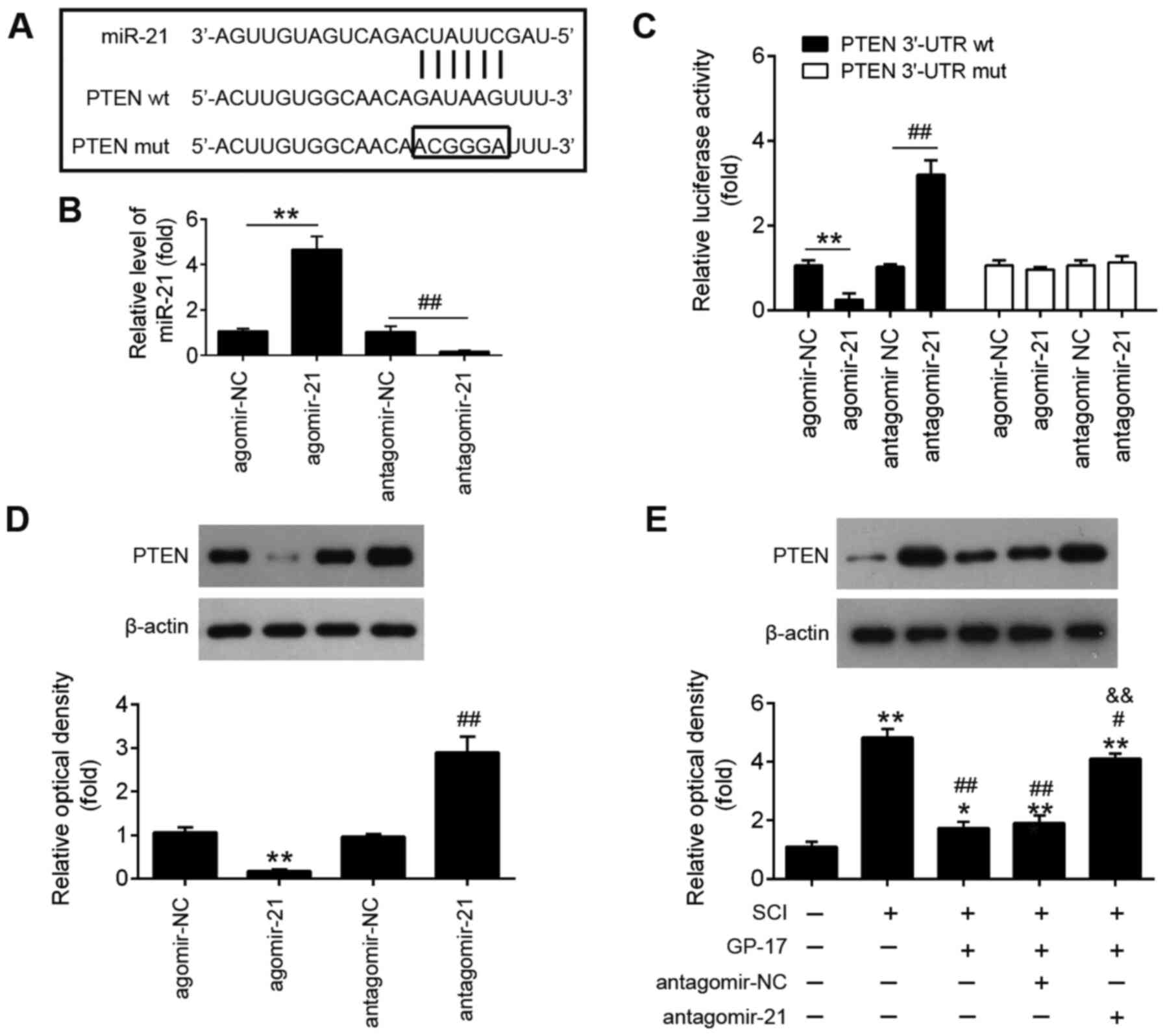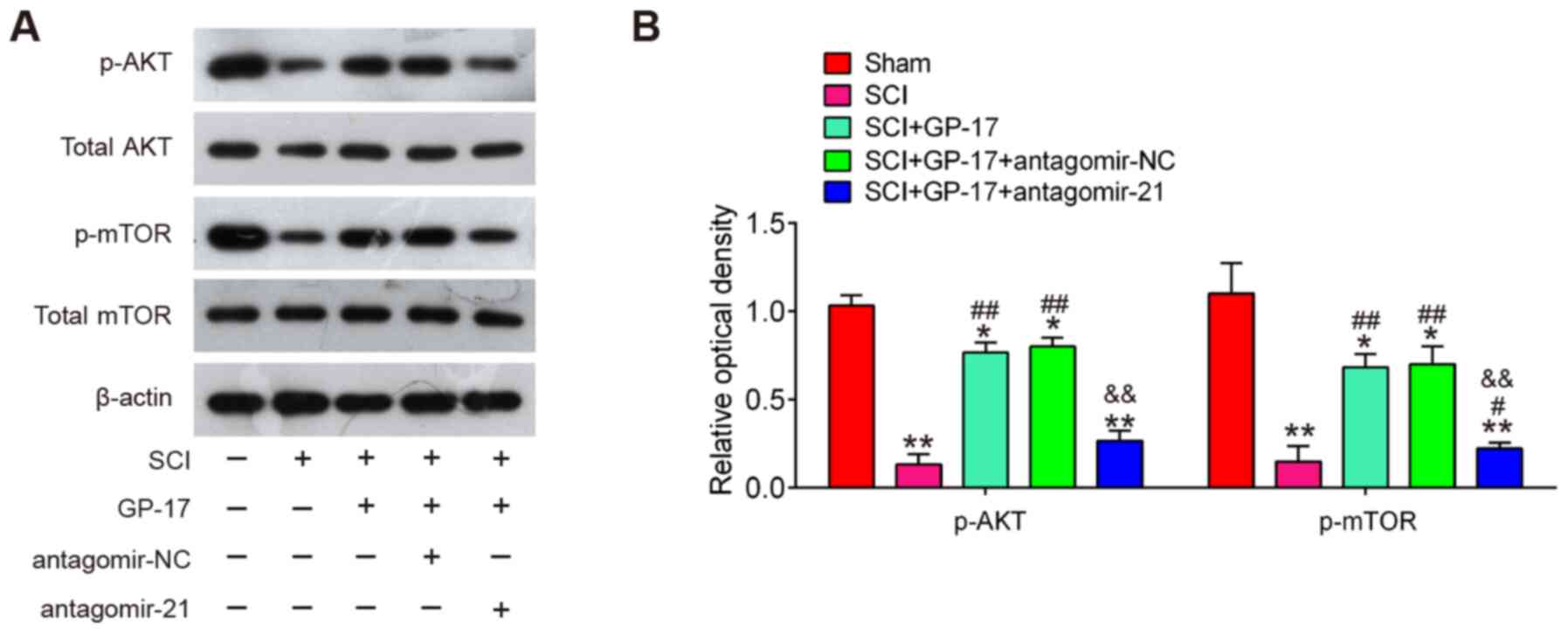|
1
|
Sekhon LH and Fehlings MG: Epidemiology,
demographics, and pathophysiology of acute spinal cord injury.
Spine (Phila Pa 1976). 26(Suppl 24): S2–S12. 2001. View Article : Google Scholar
|
|
2
|
Goldshmit Y, Kanner S, Zacs M, Frisca F,
Pinto AR, Currie PD and Pinkas-Kramarski R: Rapamycin increases
neuronal survival, reduces inflammation and astrocyte proliferation
after spinal cord injury. Mol Cell Neurosci. 68:82–91. 2015.
View Article : Google Scholar : PubMed/NCBI
|
|
3
|
Blight AR: Delayed demyelination and
macrophage invasion: A candidate for secondary cell damage in
spinal cord injury. Cent Nerv Syst Trauma. 2:299–315. 1985.
View Article : Google Scholar : PubMed/NCBI
|
|
4
|
Orr MB and Gensel JC: Spinal cord injury
scarring and inflammation: Therapies targeting glial and
inflammatory responses. Neurotherapeutics. 15:541–553. 2018.
View Article : Google Scholar : PubMed/NCBI
|
|
5
|
Celik EC, Erhan B, Gunduz B and Lakse E:
The effect of low-frequency TENS in the treatment of neuropathic
pain in patients with spinal cord injury. Spinal Cord. 51:334–337.
2013. View Article : Google Scholar : PubMed/NCBI
|
|
6
|
Shen L and Ji HF: The pharmacology of
curcumin: Is it the degradation products? Trends Mol Med.
18:138–144. 2012. View Article : Google Scholar : PubMed/NCBI
|
|
7
|
Jin W, Wang J, Zhu T, Yuan B, Ni H, Jiang
J, Wang H and Liang W: Anti-inflammatory effects of curcumin in
experimental spinal cord injury in rats. Inflamm Res. 63:381–387.
2014. View Article : Google Scholar : PubMed/NCBI
|
|
8
|
Ates O, Cayli S, Altinoz E, Gurses I,
Yucel N, Kocak A, Yologlu S and Turkoz Y: Effects of resveratrol
and methylprednisolone on biochemical, neurobehavioral and
histopathological recovery after experimental spinal cord injury.
Acta Pharmacol Sin. 27:1317–1325. 2006. View Article : Google Scholar : PubMed/NCBI
|
|
9
|
Zhou XM, Zhou ML, Zhang XS, Zhuang Z, Li
T, Shi JX and Zhang X: Resveratrol prevents neuronal apoptosis in
an early brain injury model. J Surg Res. 189:159–165. 2014.
View Article : Google Scholar : PubMed/NCBI
|
|
10
|
Meng X, Wang M, Sun G, Ye J, Zhou Y, Dong
X, Wang T, Lu S and Sun X: Attenuation of Aβ25-35-induced parallel
autophagic and apoptotic cell death by gypenoside XVII through the
estrogen receptor-dependent activation of Nrf2/ARE pathways.
Toxicol Appl Pharmacol. 279:63–75. 2014. View Article : Google Scholar : PubMed/NCBI
|
|
11
|
Cui CH, Kim DJ, Jung SC, Kim SC and Im WT:
Enhanced production of gypenoside LXXV using a novel
ginsenoside-transforming β-glucosidase from ginseng-cultivating
soil bacteria and its anti-cancer property. Molecules. 22:8442017.
View Article : Google Scholar
|
|
12
|
Wan ZH and Zhao Q: Gypenoside inhibits
interleukin-1β-induced inflammatory response in human
osteoarthritis chondrocytes. J Biochem Mol Toxicol. 31:2017.
View Article : Google Scholar
|
|
13
|
Meng X, Luo Y, Liang T, Wang M, Zhao J,
Sun G and Sun X: Gypenoside XVII enhances lysosome biogenesis and
autophagy flux and accelerates autophagic clearance of Amyloid-β
through TFEB activation. J Alzheimers Dis. 52:1135–1150. 2016.
View Article : Google Scholar : PubMed/NCBI
|
|
14
|
Ambros V: The functions of animal
microRNAs. Nature. 431:350–355. 2004. View Article : Google Scholar : PubMed/NCBI
|
|
15
|
Liu NK, Wang XF, Lu QB and Xu XM: Altered
microRNA expression following traumatic spinal cord injury. Exp
Neurol. 219:424–429. 2009. View Article : Google Scholar : PubMed/NCBI
|
|
16
|
Liu G, Keeler BE, Zhukareva V and Houle
JD: Cycling exercise affects the expression of apoptosis-associated
microRNAs after spinal cord injury in rats. Exp Neurol.
226:200–206. 2010. View Article : Google Scholar : PubMed/NCBI
|
|
17
|
Dai J, Xu LJ, Han GD, Sun HL, Zhu GT,
Jiang HT, Yu GY and Tang XM: MiR-137 attenuates spinal cord injury
by modulating NEUROD4 through reducing inflammation and oxidative
stress. Eur Rev Med Pharmacol Sci. 22:1884–1890. 2018.PubMed/NCBI
|
|
18
|
Lin CA, Duan KY, Wang XW and Zhang ZS:
MicroRNA-409 promotes recovery of spinal cord injury by regulating
ZNF366. Eur Rev Med Pharmacol Sci. 22:3649–3655. 2018.PubMed/NCBI
|
|
19
|
Feng JS, Sun JD, Wang XD, Fu CH, Gan LL
and Ma R: MicroRNA-204-5p targets SOX11 to regulate the
inflammatory response in spinal cord injury. Eur Rev Med Pharmacol
Sci. 23:4089–4096. 2019.PubMed/NCBI
|
|
20
|
Yi LT, Mu RH, Dong SQ, Wang SS, Li CF,
Geng D and Liu Q: MiR-124 antagonizes the antidepressant-like
effects of standardized gypenosides in mice. J Psychopharmacol.
32:458–468. 2018. View Article : Google Scholar : PubMed/NCBI
|
|
21
|
Zu ML, Piao XL, Gao JM, Xing SF and Liu
LH: Monomer gypenoside LI from Gynostemma pentaphyllum inhibits
cell proliferation and upregulates expression of miR-128-3p in
melanoma cells. J Biochem Mol Toxicol. 34:e224602020. View Article : Google Scholar : PubMed/NCBI
|
|
22
|
Lu KW, Ma YS, Yu FS, Huang YP, Chu YL, Wu
RS, Liao CL, Chueh FS and Chung JG: Gypenosides induce cell death
and alter gene expression in human oral cancer HSC-3 cells. Exp
Ther Med. 14:2469–2476. 2017. View Article : Google Scholar : PubMed/NCBI
|
|
23
|
Zhang D, Xuan J, Zheng BB, Zhou YL, Lin Y,
Wu YS, Zhou YF, Huang YX, Wang Q, Shen LY, et al: Metformin
improves functional recovery after spinal cord injury via autophagy
flux stimulation. Mol Neurobiol. 54:3327–3341. 2017. View Article : Google Scholar
|
|
24
|
Lilley E, Andrews MR, Bradbury EJ, Elliott
H, Hawkins P, Ichiyama RM, Keeley J, Michael-Titus AT, Moon LDF,
Pluchino S, et al: Refining rodent models of spinal cord injury.
Exp Neurol. 328:1132732020. View Article : Google Scholar : PubMed/NCBI
|
|
25
|
Basso DM, Beattie MS and Bresnahan JC: A
sensitive and reliable locomotor rating scale for open field
testing in rats. J Neurotrauma. 12:1–21. 1995. View Article : Google Scholar : PubMed/NCBI
|
|
26
|
Livak KJ and Schmittgen TD: Analysis of
relative gene expression data using real-time quantitative PCR and
the 2(-Delta Delta C(T)) method. Methods. 25:402–408. 2001.
View Article : Google Scholar
|
|
27
|
Zhang T, Ni S, Luo Z, Lang Y, Hu J and Lu
H: The protective effect of microRNA-21 in neurons after spinal
cord injury. Spinal Cord. 57:141–149. 2019. View Article : Google Scholar :
|
|
28
|
Zhou J, Shuang O, Li J, Cai Z, Wu C and
Wang W: MiR-34a alleviates spinal cord injury via TLR4 signaling by
inhibiting HMGB-1. Exp Ther Med. 17:1912–1918. 2019.PubMed/NCBI
|
|
29
|
Yu X, Zhang S, Zhao D, Zhang X, Xia C,
Wang T, Zhang M, Liu T, Huang W and Wu B: SIRT1 inhibits apoptosis
in in vivo and in vitro models of spinal cord injury via
microRNA-494. Int J Mol Med. 43:1758–1768. 2019.PubMed/NCBI
|
|
30
|
Zhao CL, Cui HA and Zhang XR: MiR-543-5p
inhibits inflammation and promotes nerve regeneration through
inactivation of the NF-κB in rats after spinal cord injury. Eur Rev
Med Pharmacol Sci. 23(Suppl 3): S39–S46. 2019.
|
|
31
|
Wang T, Yuan W, Liu Y, Zhang Y, Wang Z,
Chen X, Feng S, Xiu Y and Li W: MiR-142-3p is a potential
therapeutic target for sensory function recovery of spinal cord
injury. Med Sci Monit. 21:2553–2556. 2015. View Article : Google Scholar : PubMed/NCBI
|
|
32
|
Yi J, Wang D, Niu X, Hu J, Zhou Y and Li
Z: MicroRNA-155 deficiency suppresses Th17 cell differentiation and
improves locomotor recovery after spinal cord injury. Scand J
Immunol. 81:284–290. 2015. View Article : Google Scholar : PubMed/NCBI
|
|
33
|
Tang J, Guo WC, Hu JF and Yu L: Let-7
participates in the regulation of inflammatory response in spinal
cord injury through PI3K/Akt signaling pathway. Eur Rev Med
Pharmacol Sci. 23:6767–6773. 2019.PubMed/NCBI
|
|
34
|
Hu JZ, Huang JH, Zeng L, Wang G, Cao M and
Lu HB: Anti-apoptotic effect of microRNA-21 after contusion spinal
cord injury in rats. J Neurotrauma. 30:1349–1360. 2013. View Article : Google Scholar : PubMed/NCBI
|
|
35
|
Xie W, Yang SY, Zhang Q, Zhou Y, Wang Y,
Liu R, Wang W, Shi J, Ning B and Jia T: Knockdown of MicroRNA-21
promotes neurological recovery after acute spinal cord injury.
Neurochem Res. 43:1641–1649. 2018. View Article : Google Scholar : PubMed/NCBI
|
|
36
|
Gutilla EA, Buyukozturk MM and Steward O:
Long-term consequences of conditional genetic deletion of PTEN in
the sensorimotor cortex of neonatal mice. Exp Neurol. 279:27–39.
2016. View Article : Google Scholar : PubMed/NCBI
|
|
37
|
Li Y, Guo Y, Fan Y, Tian H, Li K and Mei
X: Melatonin enhances autophagy and reduces apoptosis to promote
locomotor recovery in spinal cord injury via the PI3K/AKT/mTOR
signaling pathway. Neurochem Res. 44:2007–2019. 2019. View Article : Google Scholar : PubMed/NCBI
|
|
38
|
Li W, Yao S, Li H, Meng Z and Sun X:
Curcumin promotes functional recovery and inhibits neuronal
apoptosis after spinal cord injury through the modulation of
autophagy. J Spinal Cord Med. 44:37–45. 2021. View Article : Google Scholar :
|
|
39
|
Lee JY, Choi HY, Ju BG and Yune TY:
Estrogen alleviates neuropathic pain induced after spinal cord
injury by inhibiting microglia and astrocyte activation. Biochim
Biophys Acta Mol Basis Dis. 1864:2472–2480. 2018. View Article : Google Scholar : PubMed/NCBI
|
|
40
|
Kachadroka S, Hall AM, Niedzielko TL,
Chongthammakun S and Floyd CL: Effect of endogenous androgens on
17beta-estradiol-mediated protection after spinal cord injury in
male rats. J Neurotrauma. 27:611–626. 2010. View Article : Google Scholar :
|
|
41
|
Samantaray S, Das A, Matzelle DC, Yu SP,
Wei L, Varma A, Ray SK and Banik NL: Administration of low dose
estrogen attenuates gliosis and protects neurons in acute spinal
cord injury in rats. J Neurochem. 136:1064–1073. 2016. View Article : Google Scholar
|
|
42
|
Sribnick EA, Wingrave JM, Matzelle DD,
Wilford GG, Ray SK and Banik NL: Estrogen attenuated markers of
inflammation and decreased lesion volume in acute spinal cord
injury in rats. J Neurosci Res. 82:283–293. 2005. View Article : Google Scholar : PubMed/NCBI
|
|
43
|
Hayta E and Elden H: Acute spinal cord
injury: A review of pathophysiology and potential of non-steroidal
anti-inflammatory drugs for pharmacological intervention. J Chem
Neuroanat. 87:25–31. 2018. View Article : Google Scholar
|
|
44
|
Zhu H, Xie R, Liu X, Shou J, Gu W, Gu S
and Che X: MicroRNA-494 improves functional recovery and inhibits
apoptosis by modulating PTEN/AKT/mTOR pathway in rats after spinal
cord injury. Biomed Pharmacother. 92:879–887. 2017. View Article : Google Scholar : PubMed/NCBI
|
|
45
|
Jian YP, Dong SJ, Xu SS, Fan J, Liu WJ,
Shao XW, Li T, Zhao SH and Wang YG: MicroRNA-34a suppresses
neuronal apoptosis and alleviates microglia inflammation by
negatively targeting the Notch pathway in spinal cord injury. Eur
Rev Med Pharmacol Sci. 24:1420–1427. 2020.PubMed/NCBI
|
|
46
|
Xu Z, Zhang K, Wang Q and Zheng Y:
MicroRNA124 improves functional recovery and suppresses
Bax-dependent apoptosis in rats following spinal cord injury. Mol
Med Rep. 19:2551–2560. 2019.PubMed/NCBI
|
|
47
|
Liu R, Wang W, Wang S, Xie W, Li H and
Ning B: MicroRNA-21 regulates astrocytic reaction post-acute phase
of spinal cord injury through modulating TGF-β signaling. Aging
(Albany NY). 10:1474–1488. 2018. View Article : Google Scholar
|
|
48
|
Bhalala OG, Pan L, Sahni V, McGuire TL,
Gruner K, Tourtellotte WG and Kessler JA: MicroRNA-21 regulates
astrocytic response following spinal cord injury. J Neurosci.
32:17935–17947. 2012. View Article : Google Scholar : PubMed/NCBI
|
|
49
|
Huang JH, Cao Y, Zeng L, Wang G, Cao M, Lu
HB and Hu JZ: Tetramethylpyrazine enhances functional recovery
after contusion spinal cord injury by modulation of MicroRNA-21,
FasL, PDCD4 and PTEN expression. Brain Res. 1648:35–45. 2016.
View Article : Google Scholar : PubMed/NCBI
|
|
50
|
Jiang JJ, Liu CM, Zhang BY, Wang XW, Zhang
M, Saijilafu, Zhang SR, Hall P, Hu YW and Zhou FQ: MicroRNA-26a
supports mammalian axon regeneration in vivo by suppressing
GSK3beta expression. Cell Death Dis. 6:e18652015. View Article : Google Scholar
|
|
51
|
Strickland ER, Hook MA, Balaraman S, Huie
JR, Grau JW and Miranda RC: MicroRNA dysregulation following spinal
cord contusion: Implications for neural plasticity and repair.
Neuroscience. 186:146–160. 2011. View Article : Google Scholar : PubMed/NCBI
|
|
52
|
Montalban E, Mattugini N, Ciarapica R,
Provenzano C, Savino M, Scagnoli F, Prosperini G, Carissimi C,
Fulci V, Matrone C, et al: MiR-21 is an Ngf-modulated microRNA that
supports Ngf signaling and regulates neuronal degeneration in PC12
cells. Neuromolecular Med. 16:415–430. 2014. View Article : Google Scholar : PubMed/NCBI
|
|
53
|
Strickland IT, Richards L, Holmes FE,
Wynick D, Uney JB and Wong LF: Axotomy-induced miR-21 promotes axon
growth in adult dorsal root ganglion neurons. PLoS One.
6:e234232011. View Article : Google Scholar : PubMed/NCBI
|
|
54
|
Liu NK and Xu XM: Neuroprotection and its
molecular mechanism following spinal cord injury. Neural Regen Res.
7:2051–2062. 2012.PubMed/NCBI
|
|
55
|
Lewandowski G and Steward O:
AAVshRNA-mediated suppression of PTEN in adult rats in combination
with salmon fibrin administration enables regenerative growth of
corticospinal axons and enhances recovery of voluntary motor
function after cervical spinal cord injury. J Neurosci.
34:9951–9962. 2014. View Article : Google Scholar : PubMed/NCBI
|
|
56
|
Liu K, Lu Y, Lee JK, Samara R, Willenberg
R, Sears-Kraxberger I, Tedeschi A, Park KK, Jin D, Cai B, et al:
PTEN deletion enhances the regenerative ability of adult
corticospinal neurons. Nat Neurosci. 13:1075–1081. 2010. View Article : Google Scholar : PubMed/NCBI
|
|
57
|
Zhou H, Li X, Wu Q, Li F, Fu Z, Liu C,
Liang Z, Chu T, Wang T, Lu L, et al: shRNA against PTEN promotes
neurite outgrowth of cortical neurons and functional recovery in
spinal cord contusion rats. Regen Med. 10:411–429. 2015. View Article : Google Scholar
|
|
58
|
Li X, Dai Y and Xu J: MiR-21 promotes
pterygium cell proliferation through the PTEN/AKT pathway. Mol Vis.
24:485–494. 2018.
|
|
59
|
Liu HY, Zhang YY, Zhu BL, Feng FZ, Yan H,
Zhang HY and Zhou B: MiR-21 regulates the proliferation and
apoptosis of ovarian cancer cells through PTEN/PI3K/AKT. Eur Rev
Med Pharmacol Sci. 23:4149–4155. 2019.PubMed/NCBI
|
|
60
|
Qin S, Wang H, Liu G, Mei H and Chen M:
MiR215p ameliorates hyperoxic acute lung injury and decreases
apoptosis of AEC II cells via PTEN/AKT signaling in rats. Mol Med
Rep. 20:4953–4962. 2019.PubMed/NCBI
|
|
61
|
Lv X, Liang J and Wang Z: MiR-21-5p
reduces apoptosis and inflammation in rats with spinal cord injury
through PI3K/AKT pathway. Panminerva Med. Jul 27–2020.
|















